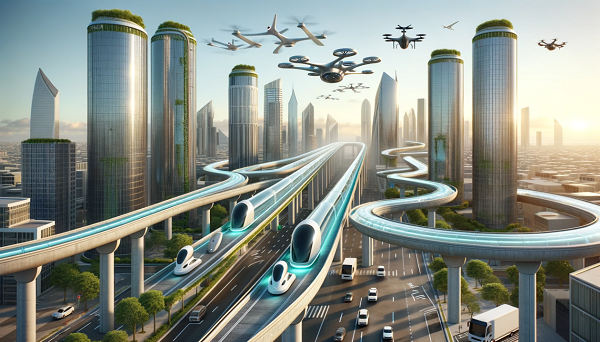As cities around the globe grapple with rapid urbanization, the demand for efficient, sustainable, and innovative transport solutions has never been higher.
The challenges posed by traffic congestion, pollution, and the need for accessible transit systems require a rethinking of urban mobility. Fortunately, technology and innovation are leading the charge, transforming the way we move within our cities.
In this article, we’ll explore some of the most exciting advancements in urban mobility and what they mean for the future.
1. The Rise of Electric Vehicles (EVs)
One of the most significant innovations in urban transport is the widespread adoption of electric vehicles (EVs). With governments pushing for greener alternatives to fossil fuel-powered cars, cities are seeing a surge in EV infrastructure.
Charging stations are popping up in parking lots, along streets, and at workplaces, making it easier for residents to switch to electric.
Moreover, many cities are incentivizing the use of EVs through subsidies, tax breaks, and dedicated lanes, fostering a cleaner environment. As battery technology improves, we can expect EVs to become even more accessible and affordable, with longer ranges and shorter charging times.
This shift not only reduces greenhouse gas emissions but also enhances air quality, leading to healthier urban environments.
2. Shared Mobility Solutions
Car-sharing and ride-sharing services have revolutionized how we think about personal transport. Companies like Uber, Lyft, and Zipcar have made it possible to access a vehicle without the burdens of ownership.
Shared mobility solutions help alleviate traffic congestion, reduce parking demand, and lower emissions, making them a vital component of the urban transport ecosystem.
As cities invest in public transit, integrating these shared services into existing systems can create a seamless travel experience for users. For instance, a commuter might take a train to a central hub and use an electric scooter or ride-share service to reach their final destination.
This approach not only maximizes efficiency but also encourages the use of public transport.
3. Autonomous Vehicles: The Road Ahead
Autonomous vehicles (AVs) hold incredible potential for urban mobility. By reducing the need for human drivers, AVs could transform public and private transport, making it safer and more efficient.
While fully autonomous vehicles are still in the testing phase, many cities are preparing for their eventual integration.
Imagine a world where self-driving shuttles operate on fixed routes, transporting commuters to and from train stations or business districts. AVs could also play a crucial role in reducing traffic accidents caused by human error, contributing to safer streets.
Furthermore, the data collected from AVs can help cities optimize traffic flow and enhance infrastructure planning.
4. Micro-Mobility: Scooters and Bikes
Micro-mobility options like e-scooters and bicycles are emerging as popular solutions for short-distance travel in urban areas. These modes of transport are not only eco-friendly but also provide a cost-effective way to navigate congested streets.
Many cities have introduced bike-sharing programs and designated scooter lanes, encouraging residents to opt for these alternatives over cars.
As urban planners recognize the importance of pedestrian-friendly environments, the integration of micro-mobility into transport networks will continue to grow.
This trend promotes a healthier lifestyle, reduces reliance on personal vehicles, and eases congestion in city centers.
5. Smart Infrastructure and IoT
The integration of smart technologies and the Internet of Things (IoT) into urban transport infrastructure is paving the way for more efficient systems. Smart traffic lights can adapt to real-time traffic conditions, optimizing flow and reducing wait times.
Connected vehicles can communicate with infrastructure to enhance safety and efficiency, while apps can provide commuters with up-to-date information on transit options and delays.
Moreover, data analytics can help city planners make informed decisions about infrastructure development, identifying areas that require improvement or expansion. This data-driven approach can lead to more sustainable and responsive transport systems.
6. Sustainable Public Transit
Public transportation remains a critical aspect of urban mobility, and cities are investing in sustainable solutions to improve these systems. Innovations like electric buses, light rail, and high-speed trains are making public transit more appealing and environmentally friendly.
By enhancing public transport options, cities can reduce the number of single-occupancy vehicles on the road, leading to less congestion and lower emissions.
Additionally, integrating technology into public transit systems can enhance the user experience. Features such as real-time tracking, mobile ticketing, and seamless connections between different modes of transport make it easier for commuters to rely on public transit as their primary means of travel.
Conclusion: A Collaborative Future
The future of urban mobility is undoubtedly exciting, with innovations driving change and shaping how we navigate our cities.
However, the successful implementation of these advancements will require collaboration among governments, private companies, and communities. As cities continue to grow, embracing a holistic approach to urban transport will be essential.
By prioritizing sustainable, accessible, and innovative solutions, we can create urban environments that not only enhance mobility but also improve the quality of life for all residents.
The journey toward a more connected, efficient, and environmentally friendly future is just beginning, and it promises to be transformative.
As we embrace these innovations, we pave the way for cities where mobility is not just a means of getting from point A to point B but a seamless, enjoyable part of everyday life.
Also Read
Global Seaport Rankings: Which ports Are leading the way in 2024?
Tire pressure matters: The hidden key to optimal vehicle performance


